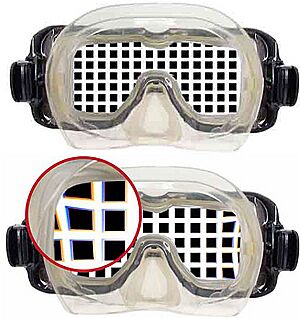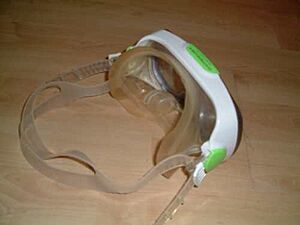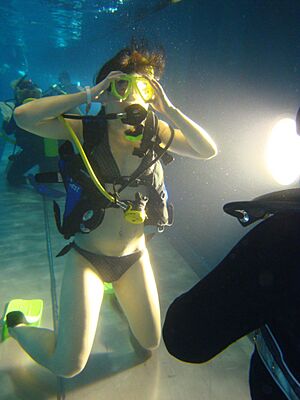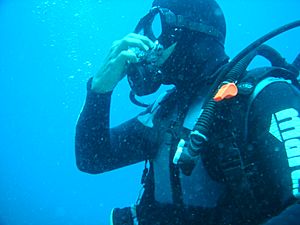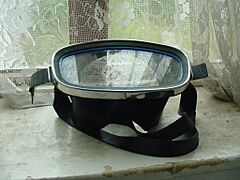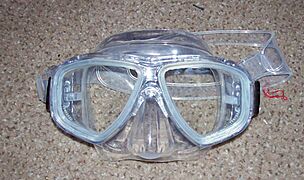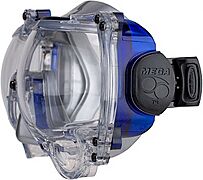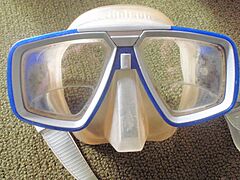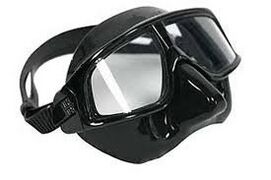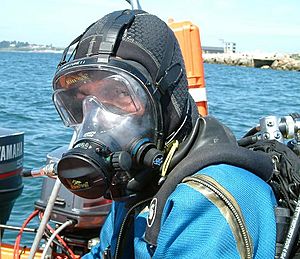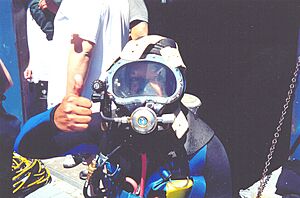Diving mask facts for kids

Snorkeler wearing a clear silicone diving mask
|
|
| Other names |
|
|---|---|
| Uses | Provides clear underwater vision for divers |
| Related items | Full-face mask, Swimming goggles |
A diving mask (also called a half mask or scuba mask) is a key piece of diving equipment. It helps people like scuba divers, free-divers, and snorkelers see clearly underwater.
When your eyes are directly in water, light bends differently. This makes it hard for your eyes to focus. A diving mask creates an air space in front of your eyes. This air space lets your eyes focus almost normally.
As you dive deeper, the water pressure increases. You need to add air to your mask to balance this pressure. This stops a painful squeeze on your face called mask squeeze. You do this by breathing a little air out through your nose into the mask. When you come up, the extra air escapes easily.
Diving masks come in many shapes and sizes. A good mask fits your face comfortably and seals tightly. This stops water from getting in. There are also quality standards to make sure masks are made well.
Contents
How We See Underwater
Light rays bend when they move from one material to another. This bending is called refraction. Our eyes are made to see in air. Water bends light almost the same way as the front part of our eye (the cornea). This means our eyes can't focus well in water. Everything looks very blurry.
A flat diving mask helps us see clearly. It puts a layer of air between your eyes and the water. Light from the water enters the mask's flat window. Then it passes into the air space inside the mask. This air space allows your eyes to focus properly.
Because of how light bends, objects underwater look about 34% bigger. They also appear 25% closer. Water also acts like a color filter. As you go deeper, the water removes red light. This leaves mostly blue light. Eventually, it gets too dark to see without a light.
Parts of a Diving Mask
A "half mask" covers your eyes and nose. A full face mask covers your eyes, nose, and mouth. We are focusing on the half mask here.
Diving masks usually have a strong, tempered glass window. Some masks have one large window. Others have two separate lenses, one for each eye. These windows are held by a strong plastic or metal frame. Some masks are "frameless," meaning the lenses are directly attached to the soft part of the mask.
The soft part of the mask is called the "skirt." It is usually made of synthetic rubber or silicone. The skirt creates a watertight seal against your face. The skirt can be clear, cloudy, or solid colored. A clear skirt gives you a wider view. But sometimes, light from the sides can cause reflections.
The skirt also covers your nose. This is important! It lets you breathe air into the mask to balance the pressure. The nose part also lets you pinch your nostrils. This helps you equalize the pressure in your ears.
All masks have a strap to hold them on your head. This strap is usually made of the same material as the skirt. It is often wider at the back for comfort and stability.
Some older masks had a special valve under the nose to let water out. These are not common anymore. They often leaked and were not very useful.
Special Lenses for Masks
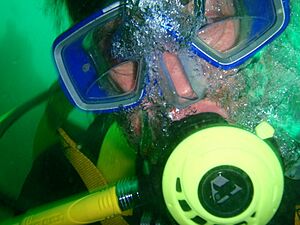
If you wear glasses, you can get a diving mask with prescription lenses. These lenses are glued to the inside of the mask's window. This helps you see clearly both above and below water. You can even get bifocal lenses for reading.
Some masks have lenses that you can easily remove and replace. This lets you put in standard prescription lenses. There are also stick-on plastic lenses. But these might fall off if your mask fills with water. You can also wear contact lenses under your mask. Just be careful not to lose them if your mask comes off.
Finding the Right Fit
A good mask fits comfortably and seals well all around your face. It should give you a wide view. It should not press on your nose or forehead.
To test a mask, put it on your face without the strap. Gently breathe in through your nose. If the mask stays on your face without falling, it means it has a good seal. No air is leaking in.
Make sure no hair gets under the mask's seal. Even a single hair can cause a leak. Most divers with beards learn to handle small leaks easily. Also, check that your nose fits comfortably in the nose pocket. Your eyelashes should not touch the glass when you blink.
Using Your Diving Mask
Adjust the mask strap so it's snug, but not too tight. A strap that is too loose might let water in. A strap that is too tight can be uncomfortable.
When you enter the water, hold your mask to keep it from being knocked off. Or, you can put your mask on after you get in the water. Avoid wearing your mask pushed up on your forehead. It can easily fall off or get knocked off.
To stop your mask from fogging up, many divers spit into the dry mask before use. They spread the spit around the inside of the lens. Then they rinse it with a little water. This makes any condensation spread out instead of forming foggy droplets. You can also buy special anti-fog solutions.
After each dive, rinse your mask with fresh water. Let it dry away from direct sunlight. Sunlight can damage the mask's materials. A well-cared-for mask can last for many years. The strap is often the first part to wear out, but it can usually be replaced. Always check your strap for damage before a dive.
Learning to take your mask off and put it back on underwater is a basic diving skill. All divers must learn this. It helps you stay calm if your mask floods or comes off.
How to Clear Your Mask
Sometimes water gets into your mask. This can be annoying and make it hard to see. You need to know how to get the water out quickly. Water can leak in if the mask doesn't fit well. It can also leak if hair gets under the seal. Moving your face muscles or bumping the mask can also cause leaks.
To clear a half mask, tilt your head back slightly. Press the top edge of the mask against your forehead. Then, breathe out slowly through your nose. The air will push the water out the bottom of the mask. If your mask has a purge valve, hold your head so the valve is at the lowest point. Then exhale through your nose.
Equalizing Mask Pressure
As you go deeper, the water pressure increases. This pressure can squeeze the air space in your mask. This can be painful. To prevent this, you must "equalize" your mask. You do this by breathing a small amount of air out through your nose into the mask. Any extra air will simply bubble out.
Equalizing your mask is a must-have skill for any diver. Goggles that don't cover your nose cannot be equalized. This makes them unsafe for diving.
You also need to equalize the pressure in your ears. This prevents pain or damage to your ears. Some divers need to pinch their nose to do this. Your mask must allow you to do this easily.
Different Kinds of Masks
Early diving masks had one large window. This window was often oval, round, or rectangular. These masks had small indents near the nose. Divers could use their thumb and finger to pinch their nose. This helped them clear their ears. Later, masks were designed with the window closer to the face. This made the mask smaller inside. It also made it easier to clear water. The nose area was covered by the mask skirt, making it easier to pinch your nose.
A newer design has two separate windows, one for each eye. These masks can sit even closer to your face. This means they have less air inside. Less air makes them easier to clear and equalize. These are often called "low-volume masks." Players in Underwater Hockey often use these masks. If a heavy puck hits a single-lens mask, the glass might break. But with a twin-lens mask, the frame helps protect your eyes even if the glass breaks.
Some new masks have special features:
- Double-dome mask: These masks have curved windows. They give a wider view and make objects appear at their true size and distance underwater. However, you might need special contact lenses to see clearly with them.
- Data Mask: This mask has a small screen built inside. It can show you important information like your depth and air tank pressure. It works like a diving computer.
Other Ways to See Underwater
Besides half masks, there are other ways to see underwater:
- Full face diving mask: These cover your whole face. Working divers often use them to talk underwater.
- Lightweight demand diving helmets: These are often used by divers who get air from the surface.
- Copper standard diving helmets: These were used in early diving.
- Fluid-filled masks: These masks are filled with water or a special liquid. They don't need to be equalized. This is helpful for free-divers who go very deep.
- Contact lenses: Some divers try wearing contact lenses. But they are not commonly used.
See also
- Underwater vision
- Human factors in diving equipment design


